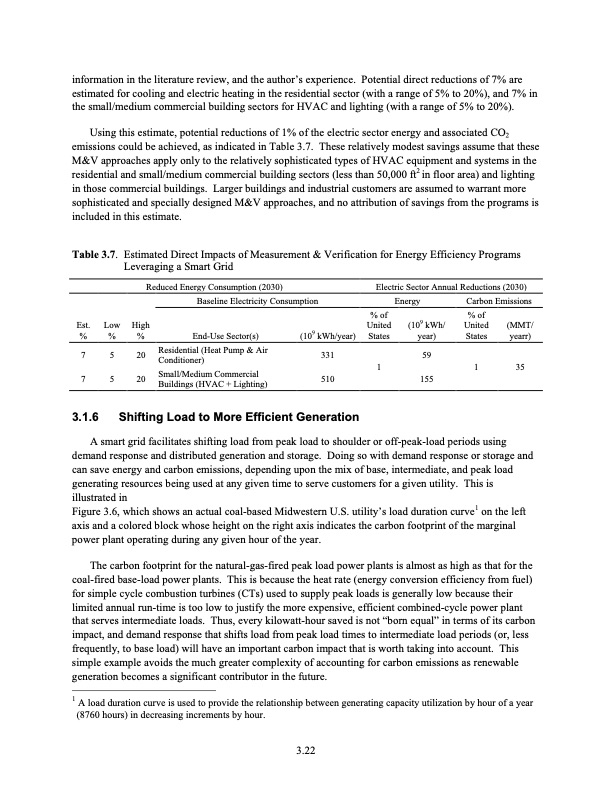
PDF Publication Title:
Text from PDF Page: 052
information in the literature review, and the author’s experience. Potential direct reductions of 7% are estimated for cooling and electric heating in the residential sector (with a range of 5% to 20%), and 7% in the small/medium commercial building sectors for HVAC and lighting (with a range of 5% to 20%). Using this estimate, potential reductions of 1% of the electric sector energy and associated CO2 emissions could be achieved, as indicated in Table 3.7. These relatively modest savings assume that these M&V approaches apply only to the relatively sophisticated types of HVAC equipment and systems in the residential and small/medium commercial building sectors (less than 50,000 ft2 in floor area) and lighting in those commercial buildings. Larger buildings and industrial customers are assumed to warrant more sophisticated and specially designed M&V approaches, and no attribution of savings from the programs is included in this estimate. Table 3.7. Estimated Direct Impacts of Measurement & Verification for Energy Efficiency Programs Leveraging a Smart Grid Reduced Energy Consumption (2030) Baseline Electricity Consumption Electric Sector Annual Reductions (2030) Energy 9 (10 kWh/ year) 59 155 Carbon Emissions Est. Low High %%% 7 5 20 7 5 20 End-UseSector(s) Residential (Heat Pump & Air Conditioner) Small/Medium Commercial Buildings (HVAC + Lighting) 9 (10 kWh/year) 331 510 % of United States 1 % of United States 1 (MMT/ yearr) 35 3.1.6 Shifting Load to More Efficient Generation A smart grid facilitates shifting load from peak load to shoulder or off-peak-load periods using demand response and distributed generation and storage. Doing so with demand response or storage and can save energy and carbon emissions, depending upon the mix of base, intermediate, and peak load generating resources being used at any given time to serve customers for a given utility. This is illustrated in Figure 3.6, which shows an actual coal-based Midwestern U.S. utility’s load duration curve1 on the left axis and a colored block whose height on the right axis indicates the carbon footprint of the marginal power plant operating during any given hour of the year. The carbon footprint for the natural-gas-fired peak load power plants is almost as high as that for the coal-fired base-load power plants. This is because the heat rate (energy conversion efficiency from fuel) for simple cycle combustion turbines (CTs) used to supply peak loads is generally low because their limited annual run-time is too low to justify the more expensive, efficient combined-cycle power plant that serves intermediate loads. Thus, every kilowatt-hour saved is not “born equal” in terms of its carbon impact, and demand response that shifts load from peak load times to intermediate load periods (or, less frequently, to base load) will have an important carbon impact that is worth taking into account. This simple example avoids the much greater complexity of accounting for carbon emissions as renewable generation becomes a significant contributor in the future. 1 A load duration curve is used to provide the relationship between generating capacity utilization by hour of a year (8760 hours) in decreasing increments by hour. 3.22PDF Image | The Smart Grid: An Estimation of the Energy and CO2 Benefits

PDF Search Title:
The Smart Grid: An Estimation of the Energy and CO2 BenefitsOriginal File Name Searched:
PNNL-19112.pdfDIY PDF Search: Google It | Yahoo | Bing
NFT (Non Fungible Token): Buy our tech, design, development or system NFT and become part of our tech NFT network... More Info
IT XR Project Redstone NFT Available for Sale: NFT for high tech turbine design with one part 3D printed counter-rotating energy turbine. Be part of the future with this NFT. Can be bought and sold but only one design NFT exists. Royalties go to the developer (Infinity) to keep enhancing design and applications... More Info
Infinity Turbine IT XR Project Redstone Design: NFT for sale... NFT for high tech turbine design with one part 3D printed counter-rotating energy turbine. Includes all rights to this turbine design, including license for Fluid Handling Block I and II for the turbine assembly and housing. The NFT includes the blueprints (cad/cam), revenue streams, and all future development of the IT XR Project Redstone... More Info
Infinity Turbine ROT Radial Outflow Turbine 24 Design and Worldwide Rights: NFT for sale... NFT for the ROT 24 energy turbine. Be part of the future with this NFT. This design can be bought and sold but only one design NFT exists. You may manufacture the unit, or get the revenues from its sale from Infinity Turbine. Royalties go to the developer (Infinity) to keep enhancing design and applications... More Info
Infinity Supercritical CO2 10 Liter Extractor Design and Worldwide Rights: The Infinity Supercritical 10L CO2 extractor is for botanical oil extraction, which is rich in terpenes and can produce shelf ready full spectrum oil. With over 5 years of development, this industry leader mature extractor machine has been sold since 2015 and is part of many profitable businesses. The process can also be used for electrowinning, e-waste recycling, and lithium battery recycling, gold mining electronic wastes, precious metals. CO2 can also be used in a reverse fuel cell with nafion to make a gas-to-liquids fuel, such as methanol, ethanol and butanol or ethylene. Supercritical CO2 has also been used for treating nafion to make it more effective catalyst. This NFT is for the purchase of worldwide rights which includes the design. More Info
NFT (Non Fungible Token): Buy our tech, design, development or system NFT and become part of our tech NFT network... More Info
Infinity Turbine Products: Special for this month, any plans are $10,000 for complete Cad/Cam blueprints. License is for one build. Try before you buy a production license. May pay by Bitcoin or other Crypto. Products Page... More Info
| CONTACT TEL: 608-238-6001 Email: greg@infinityturbine.com | RSS | AMP |